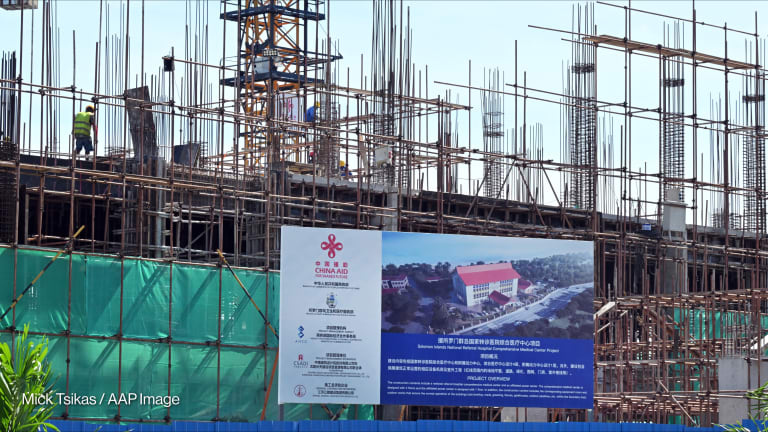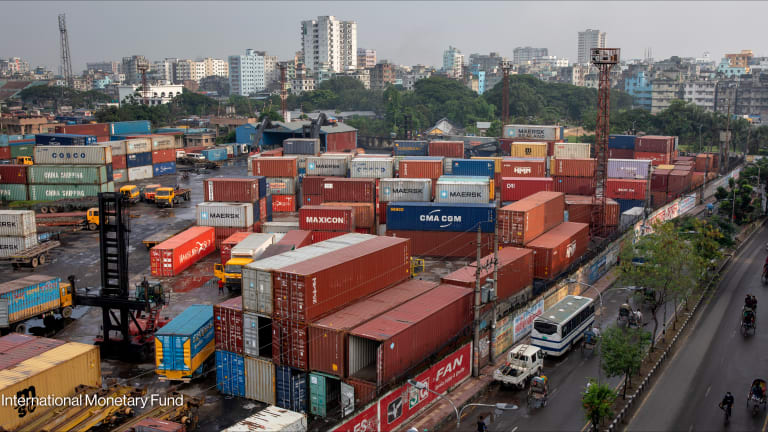How much has the US spent on humanitarian aid?
The United States spent nearly $83.2 billion on humanitarian aid between 2012 and 2021 — more than half the total aid from Development Assistance Committee member countries. Here’s our analysis.
The United States is the world’s biggest bilateral donor, spending $47.8 billion in 2021. This accounted for over a quarter of the total official development assistance, or ODA, from the Development Assistance Committee member countries. A significant portion of this ODA went to humanitarian aid. Donors report their aid spending to the Organisation for Economic Co-operation and Development, which also tracks its sectoral and geographic flows — including humanitarian activities to bilateral recipients. OECD defines humanitarian aid as in-kind or monetary assistance for emergency response to any human-made or natural disasters. The activities range from urgent needs, such as emergency food aid, to long-term projects, such as reconstruction and rehabilitation and disaster prevention and preparedness. In this article, we look into how much the U.S. spent on humanitarian aid within a 10-year period. OECD provides separate data on providers and recipients. With providers, data is based on disbursed funding, while with recipients, it is based on commitments. Additionally, the date range for these two groups is different. The total ODA disbursement by providers covers a period up to 2021, while the ODA commitment by bilateral recipients only covers up to 2020. But in both cases, we analyzed a decade-worth of data. OECD used 2020 U.S. dollar constant prices in reporting the annual humanitarian aid spending. We applied the same methodology to the bilateral flow — which was originally in current prices — allowing us to make comparisons with respect to changes in inflation rates. Humanitarian aid in numbers Based on OECD data, the U.S. disbursed $83.2 billion between 2012 and 2021 — accounting for more than half of DAC’s $156 billion total humanitarian aid spending. From $4.7 billion in 2012, its assistance more than tripled to $15.1 billion in 2021. While the U.S. was the biggest humanitarian aid donor by volume in 2021, it was 15th among the other donors when it is measured against its gross national income. According to the Development Initiatives’ Global Humanitarian Assistance Report 2022, U.S. humanitarian aid only represented 0.04% of its GNI. Humanitarian aid dipped on three occasions — 2015, 2018, and 2020 — but the U.S.’s average annual growth rate within the 10-year period was higher than DAC’s — 15.8% to 13.2%. Compared to total aid spending using OECD’s grant equivalent methodology, more than 20% of U.S. ODA between 2018 and 2021 went to humanitarian response: • 2018: $7.5 billion, or 21.4% of total ODA. • 2019: $9.4 billion, or 27.9% of total ODA. • 2020: $9.4 billion, or 26.5% of total ODA. • 2021: $15.1 billion, or 32.8% of total ODA. Agencies responsible for humanitarian assistance The U.S. State Department’s Bureau of Population, Refugees, and Migration and the U.S. Agency for International Development’s Bureau for Humanitarian Assistance act as the lead U.S. agencies for humanitarian aid. PRM focuses on the rights and welfare of persecuted and forcibly displaced people. The bureau provides support to refugees and migrants throughout the world, as well as those housed in the United States. It also formulates humanitarian goals and policies across the U.S. government. On the other hand, BHA is the primary agency for international disaster assistance — providing shelters, food, and essential supplies. It also funds long-term recovery, risk-reduction and prevention programs. According to its financial report, BHA spent more than $11.8 billion on emergency response in 64 countries in 2022. Top bilateral recipients According to OECD, the U.S. committed nearly $72.9 billion on bilateral humanitarian aid between 2011 and 2020. From $4.8 billion in 2011, the allocation almost doubled to $9.4 billion in 2020. The majority of aid went to Africa — $50.2 billion, or 68.9% of the total. Latin America and the Caribbean received $2.7 billion; South Asia, $2.5 billion; and Central Asia, $1.9 billion. A further $7.6 billion was spent on humanitarian activities targeting several countries from different regions. OECD labels it as “development countries, unspecified.” Syria was the biggest recipient among countries, with $6.8 billion — or 9.3% of the total. Humanitarian aid to the country jumped from $21.8 million in 2011 to $186.8 million in 2012. It then skyrocketed further to $681.8 million in 2013. A civil war that started in early 2011 prompted the U.S. to increase its aid to Syria — which then remained over $700 million from 2014, reaching as high as $950.3 million in 2017. South Sudan ranked next, with $5.1 billion — 7% of the total. The country experienced a number of crises following its independence from Sudan in 2011 — armed conflicts, cholera outbreaks, food insecurity, and natural calamities. As a response to a civil war that erupted in 2013, the U.S. increased humanitarian assistance and overall development aid to the country. From $302.1 million in 2013, humanitarian aid almost tripled to $839.7 million the following year. Ethiopia was also among the priorities, with $3.8 billion — 5.2% of the total. Drought, displacement, food insecurity, and persistent conflicts drove the country toward a complex humanitarian emergency. Humanitarian assistance to the country peaked in 2017, with $555 million. Try out Devex Pro Funding today with a free 5-day trial, and explore funding opportunities from over 850 sources in addition to our analysis and news content.
The United States is the world’s biggest bilateral donor, spending $47.8 billion in 2021. This accounted for over a quarter of the total official development assistance, or ODA, from the Development Assistance Committee member countries.
A significant portion of this ODA went to humanitarian aid.
Donors report their aid spending to the Organisation for Economic Co-operation and Development, which also tracks its sectoral and geographic flows — including humanitarian activities to bilateral recipients.
This story is forDevex Promembers
Unlock this story now with a 15-day free trial of Devex Pro.
With a Devex Pro subscription you'll get access to deeper analysis and exclusive insights from our reporters and analysts.
Start my free trialRequest a group subscription Printing articles to share with others is a breach of our terms and conditions and copyright policy. Please use the sharing options on the left side of the article. Devex Pro members may share up to 10 articles per month using the Pro share tool ( ).
Miguel Tamonan is a Senior Development Analyst at Devex, where he analyzes data from public and private donors to produce content and special reports for Pro and Pro Funding readers. He has a bachelor’s degree in Political Science with a Major in International Relations from the Polytechnic University of the Philippines.








